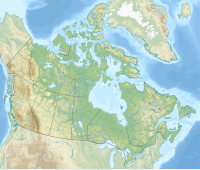Glacier Peak (Bow Range)
| Glacier Peak | |
|---|---|
 Glacier Peak (centered) with Mount Lefroy in upper left and Ringrose Peak in upper right as seen from Lake Oesa | |
| Highest point | |
| Elevation | 3,302 m (10,833 ft)[1] |
| Prominence | 72 m (236 ft)[1] |
| Listing | |
| Coordinates | 51°21′03″N 116°17′04″W / 51.35083°N 116.28444°W[2] |
| Geography | |
| Country | Canada |
| Provinces | Alberta and British Columbia |
| Protected area | Banff National Park[3] |
| Parent range | Bow Range[3] |
| Topo map | NTS 82N8 Lake Louise |
| Climbing | |
| First ascent | 1909 V. Fynn; A. Hart; C. Richardson; L. Wilson[4] |
Glacier Peak is a mountain in Banff National Park and straddles the Continental Divide marking the Alberta-British Columbia border. It is situated between Mount Lefroy and Ringrose Peak in the Bow Range of the Canadian Rockies.[3] It was named in 1894 by Samuel E.S. Allen in reference to the glacier on the northern side of the mountain.[4][1]
Geology
[edit]Glacier Peak is composed of sedimentary rock laid down during the Precambrian to Jurassic periods.[5] Formed in shallow seas, this sedimentary rock was pushed east and over the top of younger rock during the Laramide orogeny.[6]
Climate
[edit]Based on the Köppen climate classification, Glacier Peak is located in a subarctic climate zone with cold, snowy winters, and mild summers.[7] Temperatures can drop below −20 °C with wind chill factors below −30 °C.
Gallery
[edit]-
Glacier Peak in upper right corner
-
Glacier Peak, north aspect
See also
[edit]References
[edit]- ^ a b c "Glacier Peak". Bivouac.com. Retrieved 2010-02-11.
- ^ "Glacier Peak". BC Geographical Names. Retrieved 2014-07-21.
- ^ a b c NTS map sheet 82N08
- ^ a b "Glacier Peak". cdnrockiesdatabases.ca. Retrieved 2019-08-17.
- ^ Belyea, Helen R. (1960). The Story of the Mountains in Banff National Park (PDF). parkscanadahistory.com (Report). Ottawa: Geological Survey of Canada. Archived (PDF) from the original on 2015-10-02. Retrieved 2019-09-13.
- ^ Gadd, Ben (2008), Geology of the Rocky Mountains and Columbias
- ^ Peel, M. C.; Finlayson, B. L.; McMahon, T. A. (2007). "Updated world map of the Köppen−Geiger climate classification". Hydrol. Earth Syst. Sci. 11 (5): 1633–1644. Bibcode:2007HESS...11.1633P. doi:10.5194/hess-11-1633-2007. ISSN 1027-5606.
External links
[edit]- Parks Canada web site: Yoho National Park
- Parks Canada web site: Banff National Park





